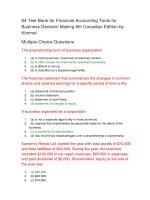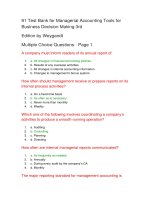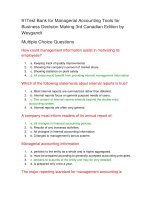Managerial accounting tools for business decision making 6th edition by weygandt kimmel and kieso solution manual download
Bạn đang xem bản rút gọn của tài liệu. Xem và tải ngay bản đầy đủ của tài liệu tại đây (1.89 MB, 28 trang )
Solution Manual for Managerial Accounting Tools for Business Decision Making 6th Edition
by Weygandt Kimmel and Kieso
CHAPTER 2
Job Order Costing
ASSIGNMENT CLASSIFICATION TABLE
Learning Objectives
1.
Questions
Brief
Exercises
Do It!
Exercises
A
Problems
B
Problems
Explain the characteristics 1, 2, 3, 4
and purposes of cost accounting.
2.
Describe the flow of
5, 6, 7, 8
1, 2
1
1, 2, 3, 4, 6, 1A, 2A,
order
7, 8, 9, 11
3A, 5A 3B, 5B costing system.
3.
Explain the nature
11, 12 8, 10, 12
4.
Indicate how the
8, 11, 12, 13
5.
Prepare entries for jobs
and sold. 7, 8, 9,
9, 10, 3, 4, 5 2
1, 2, 3, 6, 7, 1A, 2A,
3A, 5A 3B, 5B a job cost sheet.
1B, 2B, costs in a job
1B, 2B, and importance of
13, 14, 15
6, 7
2
2, 3, 5, 6, 7, 1A, 2A, 3A, 1B, 2B, 3B, predetermined
4A, 5A 4B, 5B overhead rate is determined and used.
16
8, 9
3
3A, 5A 3B, 5B
2, 3, 6,
1A, 2A,
1B, 2B, completed
10, 11
6.
Distinguish between 17, 18 10 4 4, 5, 12, 13 1A, 2A, 1B, 2B, under- and overapplied
manufacturing overhead.
4A, 5A 4B, 5B
2-1
Copyright © 2012 John Wiley & Sons, Inc. Weygandt, Managerial Accounting, 6/e, Instructor’s Manual (For Instructor Use Only)
ASSIGNMENT CHARACTERISTICS TABLE
Problem
Number
Description
Difficulty
Level
Time
Allotted (min.)
Simple
30−40
1A
Prepare entries in a job order cost system and job cost
sheets.
2A
Prepare entries in a job order cost system and partial
income statement.
Moderate
30−40
3A
Prepare entries in a job order cost system and cost of
goods manufactured schedule.
Simple
30−40
4A
Compute predetermined overhead rates, apply overhead,
and calculate under- or overapplied overhead.
Simple
20−30
5A
Analyze manufacturing accounts and determine missing
amounts.
Complex
30−40
1B
Prepare entries in a job order cost system and job cost
sheets.
Simple
30−40
2B
Prepare entries in a job order cost system and partial
income statement.
Moderate
30−40
3B
Prepare entries in a job order cost system and cost of
goods manufactured schedule.
Simple
30−40
4B
Compute predetermined overhead rates, apply overhead,
and calculate under- or overapplied overhead.
Simple
20−30
5B
Analyze manufacturing accounts and determine missing
amounts.
Complex
30−40
BLOOM’S TAXONOMY TABLE
2-2
Copyright © 2012 John Wiley & Sons, Inc. Weygandt, Managerial Accounting, 6/e, Instructor’s Manual (For Instructor Use Only)
2-3
2-4
Copyright © 2012 John Wiley & Sons, Inc. Weygandt, Managerial Accounting, 6/e, Instructor’s Manual (For Instructor Use Only)
2-5
Copy right © 2012 John Wiley & Sons, Inc.
Weyg andt, Managerial Accounting, 6/e, Instructor’s Manual
(For Instructor Use Only)
LEARNING OBJECTIVES
1. EXPLAIN THE CHARACTERISTICS AND PURPOSES
OF COST ACCOUNTING.
2. DESCRIBE THE FLOW OF COSTS IN A JOB ORDER
COST ACCOUNTING SYSTEM.
3. EXPLAIN THE NATURE AND IMPORTANCE OF A
JOB COST SHEET.
4. INDICATE HOW THE PREDETERMINED OVERHEAD RATE
IS DETERMINED AND USED.
5. PREPARE ENTRIES FOR JOBS COMPLETED AND SOLD.
6. DISTINGUISH BETWEEN UNDER- AND
OVERAPPLIED MANUFACTURING OVERHEAD.
2-6
Copyright © 2012 John Wiley & Sons, Inc. Weygandt, Managerial Accounting, 6/e, Instructor’s Manual (For Instructor Use Only)
CHAPTER REVIEW
Cost Accounting Systems
1.
(L.O. 1) Cost accounting involves the measuring, recording, and reporting of product costs. From
the data accumulated, both the total cost and unit cost of each product is determined.
2.
A cost accounting system consists of accounts for the various manufacturing costs. These
accounts are fully integrated into the general ledger of a company. An important feature of a cost
accounting system is the use of a perpetual inventory system. Such a system provides
information immediately on the cost of a product. The two basic types of cost accounting
systems are (a) a job order cost system and (b) a process cost system.
3.
Under a job order cost system, costs are assigned to each job or to each batch of goods.
4.
A process cost system is used when a large volume of similar products are manufactured.
Process costing accumulates product-related costs for a period of time instead of assigning
costs to specific products or job orders.
Job Order Cost Flow
5.
(L.O. 2) The flow of costs in job order cost accounting parallels the physical flow of the materials
as they are converted into finished goods. There are two major steps in the flow of costs: (a)
accumulating the manufacturing costs incurred and (b) assigning the accumulated costs to the
work done.
6.
A company accumulates manufacturing costs incurred by debits to Raw Materials Inventory,
Factory Labor, and Manufacturing Overhead..
7.
The assignment of manufacturing costs involves entries to Work in Process Inventory, Finished
Goods Inventory, and Cost of Goods Sold.
8.
The cost of raw materials purchased is debited to Raw Materials Inventory when materials are
received.
9.
Factory labor costs are debited to Factory Labor when they are incurred. The cost of factory labor
consists of (1) gross earnings of factory workers, (2) employer payroll taxes on the earnings, and
(3) fringe benefits incurred by the employer.
10.
Manufacturing overhead costs are recognized as incurred and periodically through adjusting
entries. The costs are debited to Manufacturing Overhead.
Assigning Manufacturing Costs to Work in Process
11. (L.O. 3) The assignment of manufacturing overhead costs to work in process involves debits to
Work in Process Inventory and credits to Raw Materials Inventory, Factory Labor, and
Manufacturing Overhead.
Copyright © 2012 John Wiley & Sons, Inc. Weygandt, Managerial Accounting, 6/e, Instructor’s Manual (For Instructor Use Only)
2-7
Job Cost Sheet
12.
A job cost sheet is a form used to record the costs chargeable to a specific job and to determine
the total and unit cost of the completed job. A separate job cost sheet is kept for each job. A
subsidiary ledger consists of individual records for each individual item (each job). The Work in
Process account is referred to as a control account because it summarizes the detailed data
regarding specific jobs contained in the job cost sheets. Each entry to Work in Process Inventory
must be accompanied by a corresponding posting to one or more job cost sheets.
13.
Raw materials costs are assigned when the materials are issued by the storeroom. Work in
Process Inventory is debited for direct materials used, Manufacturing Overhead is debited for
indirect materials used, and Raw Materials Inventory is credited.
14.
Factory labor costs are assigned to jobs on the basis of time tickets prepared when the work is
performed. Work in Process Inventory is debited for direct labor costs, Manufacturing Overhead
is debited for indirect labor costs, and Factory Labor is credited.
Manufacturing Overhead Costs
15.
(L.O. 4) Manufacturing overhead relates to production operations as a whole and therefore
cannot be assigned to specific jobs on the basis of actual costs incurred. Instead, manufacturing
overhead is assigned to work in process and to specific jobs on an estimated basis through the
use of a predetermined overhead rate.
16.
The predetermined overhead rate is based on the relationship between estimated annual
overhead costs and expected annual operating activity. This relationship is expressed in terms of
a common activity base such as direct labor costs, direct labor hours, or machine hours.
a. The formula for the predetermined overhead rate is:
Estimated
Expected
Annual ÷ Annual Operating =
Overhead Costs Activity
b.
c.
17.
Predetermined
Overhead Rate
The use of a predetermined overhead rate enables the company to determine the
approximate total cost of each job when the job is completed.
In recent years, more companies are using machine hours as the activity base due to
increased reliance on automation in manufacturing operations.
At the end of each month, the balance in Work in Process Inventory should equal the sum of the
costs shown on the job cost sheets for unfinished jobs.
Assigning Costs to Finished Goods
18.
(L.O. 5) When a job is completed, the total cost is debited to Finished Goods Inventory and
credited to Work in Process Inventory. Finished Goods Inventory is a control account that
controls individual finished goods records in a finished goods subsidiary ledger.
19.
Cost of goods sold is recognized when a sale occurs by a debit to Cost of Goods Sold and a
credit to Finished Goods Inventory (the sale is recorded with a debit to Accounts Receivable or
Cash and a credit to Sales).
right © 2012 John Wiley & Sons, Inc. Weygandt, Managerial Accounting, 6/e, Instructor’s Manual (For Instructor Use Only)
20.
At the end of a period, financial statements are prepared that present aggregate data on all jobs
manufactured and sold.
a. The cost of goods manufactured schedule has one new feature: in determining total
manufacturing costs, manufacturing overhead applied is used instead of actual overhead
costs.
b. The cost of goods manufactured schedule is prepared directly from the Work in Process
Inventory account.
Under- or Overapplied Manufacturing Overhead
21.
(L.O. 6) Manufacturing overhead may be under- or overapplied. When Manufacturing Overhead
has a debit balance, overhead is said to be underapplied. Underapplied overhead means that
the overhead assigned to work in process is less than the overhead incurred. When
manufacturing overhead has a credit balance, overhead is overapplied. Overapplied overhead
means that the overhead assigned to work in process is greater than the overhead incurred.
22.
At the end of the year, any balance in Manufacturing Overhead is eliminated through an
adjusting entry, usually to Cost of Goods Sold.
a. Underapplied overhead is debited to Cost of Goods Sold.
b. Overapplied overhead is credited to Cost of Goods Sold.
Copyright © 2012 John Wiley & Sons, Inc. Weygandt, Managerial Accounting, 6/e, Instructor’s Manual (For Instructor Use Only)
2-9
LECTURE OUTLINE
A. Cost Accounting Systems.
1. Cost accounting involves the measuring, recording, and reporting of
product costs. From the data accumulated, companies determine both
the total cost and the unit cost of each product.
2. A cost accounting system consists of accounts for the various
manufacturing costs. These accounts are fully integrated into the
general ledger of a company. An important feature of a cost accounting
system is the use of a perpetual inventory system that provides
immediate, up-to-date information on the cost of a product.
3. There are two basic types of cost accounting systems:
TEACHING TIP
ILLUSTRATION 2-1 identifies the two basic types of cost accounting systems and
their characteristics.
a.
A job order system, where the company assigns costs to each job
or to each batch of goods, and
b.
A process cost system, used when a company manufactures a
large volume of similar products.
MANAGEMENT INSIGHT
Many companies suffer from poor cost accounting and sometimes make
products they should not be selling. The managers of a diversified company
thought they were making money, but a consulting firm found that the company
had seriously underestimated costs.
What type of costs do you think the company had been underestimating?
Answer: It is most likely that the company failed to estimate and track overhead.
In a highly diversified company, overhead associated with the diesel
right © 2012 John Wiley & Sons, Inc. Weygandt, Managerial Accounting, 6/e, Instructor’s Manual (For Instructor Use Only)
locomotive jobs may have been “lost” in the total overhead pool for
the entire company.
B.
Job Order Cost Flow.
1. The flow of costs (direct materials, direct labor, and manufacturing
overhead) in job order cost accounting parallels the physical flow of the
materials as they are converted into finished goods.
TEACHING TIP
ILLUSTRATION 2-2 provides an overview of the cost flows through the general
ledger accounts in a job order cost system. Emphasize the two steps of (1)
accumulating manufacturing costs incurred, and then (2) assigning accumulated
costs to products.
2. There are two major steps in the flow of costs:
a.
Accumulating the manufacturing costs incurred; these costs are
accumulated in three accounts: Raw Materials Inventory, Factory
Labor, and Manufacturing Overhead, and
b.
Assigning the accumulated costs to Work in Process Inventory and
eventually to Finished Goods Inventory and Cost of Goods Sold.
3. Three entries are made to accumulate the manufacturing costs incurred.
TEACHING TIP
ILLUSTRATION 2-3 provides an example of the journal entries required to
accumulate the cost of raw materials, factory labor, and actual manufacturing
overhead.
a.
When the company receives the raw materials it has purchased, it
debits the cost of the materials to Raw Materials Inventory. Raw
Materials Inventory is a control account. The subsidiary ledger
consists of individual records for each item of raw materials.
Copyright © 2012 John Wiley & Sons, Inc. Weygandt, Managerial Accounting, 6/e, Instructor’s Manual (For Instructor Use Only)
2-11
C.
b.
The cost of factory labor consists of gross earnings of factory
workers, employer payroll taxes, and fringe benefits (sick pay,
pensions, and vacation pay) incurred by the employer. Companies
debit labor costs to Factory Labor as they incur those costs.
Factory labor is assigned to work in process and manufacturing
overhead at the end of the period.
c.
A company may record overhead costs periodically through
adjusting entries by debiting Manufacturing Overhead.
Manufacturing Overhead is a control account and the subsidiary
ledger consists of individual accounts for each type of cost (factory
utilities, factory repairs, etc.).
Assigning Manufacturing Costs to Work in Process.
1. A job cost sheet is a form used to record the costs chargeable to a
specific job and to determine the total and unit costs of the completed
job. The job cost sheets constitute the subsidiary ledger for the Work in
Process Inventory account.
2. Each entry to Work in Process Inventory must be accompanied by a
corresponding posting to one or more job cost sheets.
3. Three entries are made in assigning the manufacturing costs to work in
process.
TEACHING TIP
ILLUSTRATION 2-4 provides an example of the journal entries required to assign
direct materials, direct labor, and manufacturing overhead to Work in Process
Inventory. Emphasize that actual overhead costs are not assigned to Work in
Process; instead, overhead is applied using a predetermined overhead rate.
a.
Materials requisition slips indicate the quantity and type of
materials withdrawn and the account to be charged. Companies
charge direct materials to Work in Process Inventory and indirect
materials to Manufacturing Overhead.
right © 2012 John Wiley & Sons, Inc. Weygandt, Managerial Accounting, 6/e, Instructor’s Manual (For Instructor Use Only)
b.
Companies assign factory labor costs to jobs on the basis of time
tickets prepared when the work is performed. The time ticket
indicates the hours worked, the account and job to be charged,
and the total labor cost. Companies debit the Work in Process
Inventory account for direct labor, and Manufacturing Overhead
for indirect labor.
c.
Companies assign manufacturing overhead to work in process
and to specific jobs on an estimated basis through the use of a
predetermined overhead rate. Using a predetermined overhead
rate enables a cost to be determined for a job immediately.
MANAGEMENT INSIGHT
Competitors often want to know the cost of a competing product. For a price, a
company called iSuppli will disassemble sophisticated electronics and tell you
what it would cost to replicate the product. The difference between the cost of
the parts and the cost of the labor to assemble the parts isn’t all profit. There are
nonproduction costs such as research, design, marketing, patent fees, and
selling costs.
What type of costs are research, design, marketing, patent fees, and selling
costs, and how are they treated for accounting purposes?
Answer: Product costs include materials, labor, and overhead. Costs
not related to production, such as research, design,
marketing, patent fees, and selling costs, are period costs
which are expensed in the period that they are incurred.
4. The predetermined overhead rate is based on the relationship between
estimated annual overhead costs and expected annual operating
activity, expressed in terms of a common activity base.
Copyright © 2012 John Wiley & Sons, Inc. Weygandt, Managerial Accounting, 6/e, Instructor’s Manual (For Instructor Use Only)
2-13
TEACHING TIP
Use ILLUSTRATION 2-4 again to discuss how a predetermined overhead rate is
calculated. Emphasize the importance of choosing an appropriate activity as a
base for assigning overhead.
a.
The company may state the activity in terms of direct labor costs,
direct labor hours, machine hours, or any other measure that will
provide an equitable basis for applying overhead costs to jobs.
b.
The predetermined overhead rate is established at the beginning
of the year.
5. Using a predetermined overhead rate enables the company to determine
the approximate total cost of each job when it completes the job.
6. At the end of each month, the balance in Work in Process Inventory
should equal the sum of the costs shown on the job cost sheets of
un•nished jobs.
D. Assigning Costs to Finished Goods and Cost of Goods Sold.
1. When a job is completed, the company summarizes the costs in the
applicable job cost sheet and debits Finished Goods Inventory.
Finished Goods Inventory is a control account that controls individual
finished goods records in a finished goods subsidiary ledger. Postings
to the finished goods records are made directly from completed job cost
sheets.
2. Companies recognize cost of goods sold when each sale occurs. Each
sale requires an entry debiting Cash or Accounts Receivable and
crediting Sales for the selling price and a second entry debiting Cost of
Goods Sold and crediting Finished Goods Inventory for the cost of the
goods.
right © 2012 John Wiley & Sons, Inc. Weygandt, Managerial Accounting, 6/e, Instructor’s Manual (For Instructor Use Only)
TEACHING TIP
ILLUSTRATION 2-5 provides an example of the journal entries required to assign
manufacturing costs to finished goods and to record a sale and the cost of
completed units sold.
3. Job cost sheets for a service company keep track of materials, labor,
and overhead used on a particular job similar to a manufacturer.
SERVICE COMPANY INSIGHT
Jet engines are one of the many products made by the industrial operations
division of General Electric. At prices as high as $30 million per engine GE does
its best to keep track of costs. Because of the high product costs, both the
engines themselves and the subsequent service are most likely accounted for
using job order costing. GE needs good cost records for its service jobs in order
to control its costs.
Explain why GE would use job order costing to keep track of the cost of repairing
a malfunctioning engine for a major airline.
Answer: GE operates in competitive environment. Other companies offer
competing bids to win service contracts on GE airplane engines. GE needs to
know what it costs to repair engines, so that it can present competitive bids while
still generating a reasonable profit. E. Job Order Cost Flows and Reporting Job
Cost Data.
1. A job order cost accounting system may be illustrated in a flow chart.
TEACHING TIP
ILLUSTRATION 2-6 provides a flow chart of the cost flows through the general
ledger accounts for the examples used in Illustrations 2-3, 2-4, and 2-5.
2. Entries in the job cost system also provide a summary of the inventory
control accounts and source documents for assigning costs to jobs.
Copyright © 2012 John Wiley & Sons, Inc. Weygandt, Managerial Accounting, 6/e, Instructor’s Manual (For Instructor Use Only)
2-15
TEACHING TIP
ILLUSTRATION 2-7 identifies the major source documents used to make entries
in a job order cost system.
3. The cost of goods manufactured schedule is the same as for companies that
do not use job order costing with one exception: manufacturing overhead
applied, rather than actual overhead costs, is added to direct materials and
direct labor to determine total manufacturing costs. F. Under- or Overapplied
Manufacturing Overhead.
1. Underapplied overhead means that the overhead assigned to work in
process is less than the overhead incurred (when Manufacturing
Overhead has a debit balance).
2. Overapplied overhead means that the overhead assigned to work in
process is greater than the overhead incurred (when Manufacturing
Overhead has a credit balance).
TEACHING TIP
ILLUSTRATION 2-8 contrasts actual Manufacturing Overhead with Applied
Overhead and indicates whether overhead is under- or overapplied.
3. At the end of the year, the company eliminates any balance in
Manufacturing Overhead by an adjusting entry. Under- or overapplied
overhead is generally considered to be an adjustment to cost of goods
sold.
4. The company debits underapplied overhead to cost of goods sold and it
credits overapplied overhead to cost of goods sold.
20 MINUTE QUIZ
Circle the correct answer.
True/False
1.
Under a job order system, the company assigns costs to each job, or each batch
of goods, to fill a specific customer order or replenish inventory.
right © 2012 John Wiley & Sons, Inc. Weygandt, Managerial Accounting, 6/e, Instructor’s Manual (For Instructor Use Only)
True
2.
Manufacturing costs incurred in a job order system are accumulated by debits to
Purchases, Factory Labor, and Manufacturing Overhead.
True
3.
False
A debit balance in the Manufacturing Overhead Account at the end of the
period indicates that overhead has been overapplied.
True
9.
False
The entry to record the cost of goods sold includes a debit to Finished Goods Inventory.
True
8.
False
Actual overhead costs are debited to the Manufacturing Overhead account.
True
7.
False
The requisition of factory supplies to production requires a debit to the
Manufacturing Overhead account.
True
6.
False
Manufacturing overhead costs cannot be traced directly to a specific job.
True
5.
False
Each debit to Work in Process Inventory must be accompanied by a corresponding
posting to one or more job cost sheets.
True
4.
False
False
In preparing the costs of goods manufactured schedule in job order costing,
manufacturing costs include direct materials used, direct labor used, and
manufacturing overhead applied.
TrueFalse
10.
A job cost sheet is a form used to record the costs chargeable to a specific job and to
determine the total and unit cost of the completed job.
True
False
Multiple Choice
1.
A job order cost sheet includes
a. the selling price of the job.
b. a total when a job is completed and transferred to cost of goods sold.
c. all manufacturing costs for a job.
Copyright © 2012 John Wiley & Sons, Inc. Weygandt, Managerial Accounting, 6/e, Instructor’s Manual (For Instructor Use Only)
2-17
d.
all manufacturing overhead costs for the period.
2.
Companies assign raw materials costs to jobs
a. By debiting Raw Materials Inventory and crediting Work in Process.
b. Based on a predetermined rate.
c. In response to verbal requests for indirect materials such as supplies.
d. Using any of the inventory costing methods (FIFO, LIFO, or average-cost).
3.
In a job order cost system, debits to Work in Process Inventory originate from all of
the following except
a. applying the predetermined overhead rate.
b. assigning direct labor from time tickets.
c. assigning actual manufacturing overhead costs to jobs.
d. assigning direct materials from requisition slips.
4.
The predetermined overhead rate is computed by dividing estimated
a. level of activity by estimated overhead costs.
b. level of activity by expected overhead costs.
c. overhead costs by estimated cost of jobs.
d. overhead costs by expected activity base.
5.
If annual overhead costs are expected to be $1,000,000 and 200,000 total labor hours are
anticipated (80% direct, 20% indirect), the overhead rate based on direct labor hours is a.
$6.25.
b. $5.00.
c. $25.00.
d. $4.00.
ANSWERS TO QUIZ
True/False
1. True
2. False
3. True
4. True
5. True
Multiple Choice
1.
5.
6.
7.
8.
9.
10.
True
False
False
True
True
c. 2. d. 3. c. 4. d.
a.
right © 2012 John Wiley & Sons, Inc. Weygandt, Managerial Accounting, 6/e, Instructor’s Manual (For Instructor Use Only)
ILLUSTRATION 2-1
COST ACCOUNTING SYSTEMS
Product Costs
1. Measuring
2. Recording
3. Reporting
Job Order
Cost System
Process
Cost System
1.Each job has its own
distinguishing
characteristics.
1.Similar products
continuously produced.
2.Accumulates product
costs by department
for a period of time.
2.Measures and
accumulates costs for
each job.
Total Cost
Unit Cost
ILLUSTRATION 2-2
JOB ORDER COST FLOWS
Copyright © 2012 John Wiley & Sons, Inc. Weygandt, Managerial Accounting, 6/e, Instructor’s Manual (For Instructor Use Only)
2-19
ILLUSTRATION 2-3
ACCUMULATING MANUFACTURING COST ENTRIES
right © 2012 John Wiley & Sons, Inc. Weygandt, Managerial Accounting, 6/e, Instructor’s Manual (For Instructor Use Only)
1.
Raw Materials Inventory
Accounts Payable
(Purchase of raw materials on account)
25,000
25,000
2.
Factory Labor
Factory Wages Payable
Payroll Taxes Payable
(To record factory labor costs)
50,000
46,000
4,000
3.
Manufacturing Overhead
Utilities Payable, Accumulated
Depreciation, and Prepaid Insurance
(To record overhead costs)
20,000
20,000
Copyright © 2012 John Wiley & Sons, Inc. Weygandt, Managerial Accounting, 6/e, Instructor’s Manual (For Instructor Use Only)
2-21
ILLUSTRATION 2-4
ASSIGNING MANUFACTURING COST TO WORK
IN PROCESS ENTRIES
4.
Work in Process Inventory
Manufacturing Overhead
Raw Materials Inventory
(To assign materials to jobs and overhead)
18,000
2,000
20,000
5.
Work in Process Inventory
Manufacturing Overhead
Factory Labor
(To assign labor to jobs and overhead)
42,000
8,000
50,000
6.
Work in Process Inventory
Manufacturing Overhead
(To assign overhead to jobs)
21,000
21,000
Predetermined Overhead Rate
Estimated Annual
Overhead Costs
$100,000
÷
Expected Annual
Operating Activity
Labor Cost
$200,000
Predetermined
Overhead Rate
=
50% of Labor Cost
ILLUSTRATION 2-5
ASSIGNING COSTS TO FINISHED GOODS AND
COST OF GOODS SOLD ENTRIES
right © 2012 John Wiley & Sons, Inc. Weygandt, Managerial Accounting, 6/e, Instructor’s Manual (For Instructor Use Only)
7.
Finished Goods Inventory
Work in Process Inventory
(To record completion of job)
8.
Accounts Receivable
Sales
(To record sale of job)
75,000
75,000
150,000
150,000
75,000
Cost of Goods Sold
Finished Goods Inventory
(To record cost of sale)
75,000
Copyright © 2012 John Wiley & Sons, Inc. Weygandt, Managerial Accounting, 6/e, Instructor’s Manual (For Instructor Use Only)
2-23
ILLUSTRATION 2-6
JOB ORDER COST FLOWS
right © 2012 John Wiley & Sons, Inc. Weygandt, Managerial Accounting, 6/e, Instructor’s Manual (For Instructor Use Only)
ILLUSTRATION 2-7
FLOW OF DOCUMENTS—JOB COST SYSTEM
ILLUSTRATION 2-8
Copyright © 2012 John Wiley & Sons, Inc. Weygandt, Managerial Accounting, 6/e, Instructor’s Manual (For Instructor Use Only)
2-25









